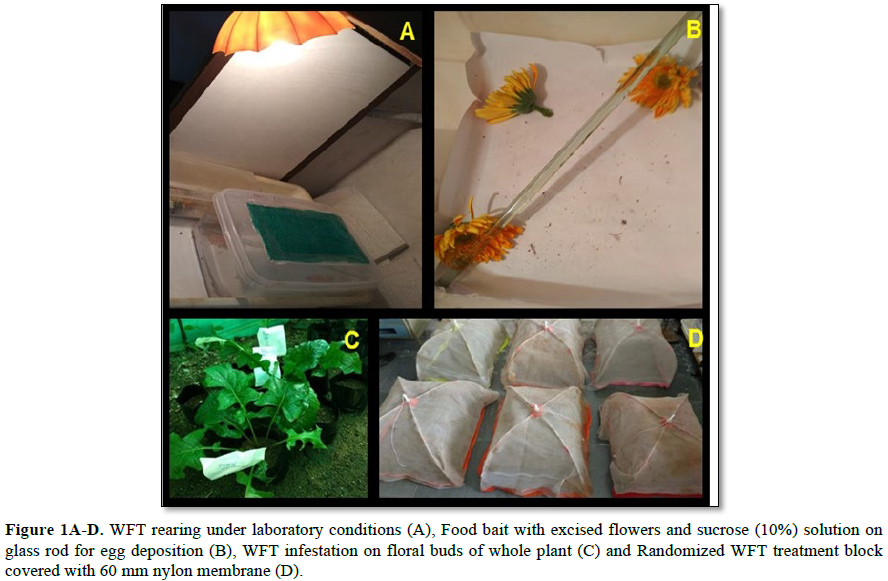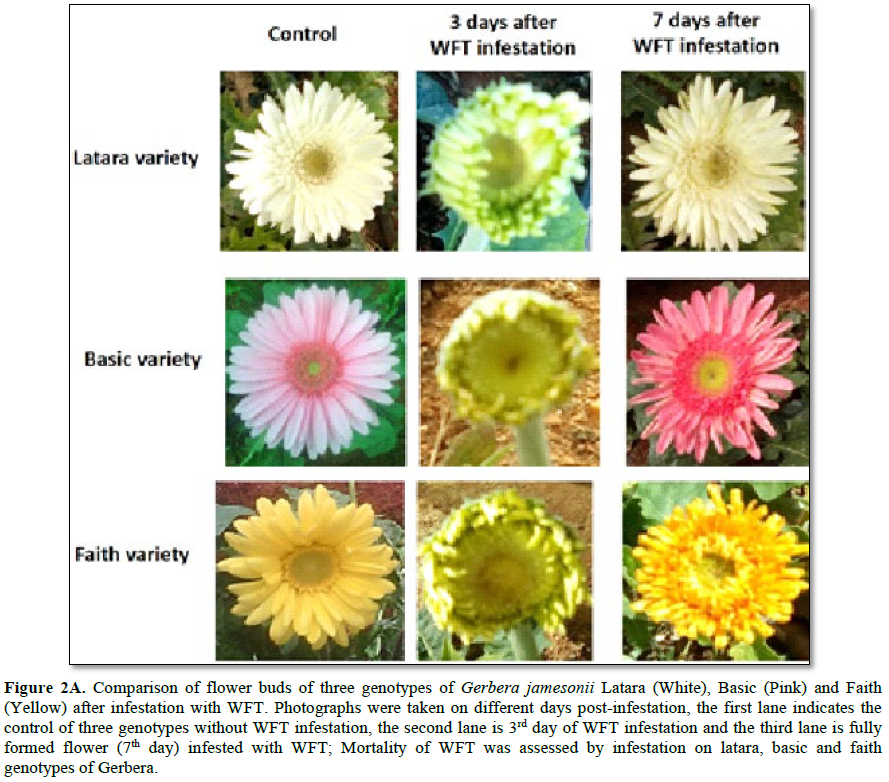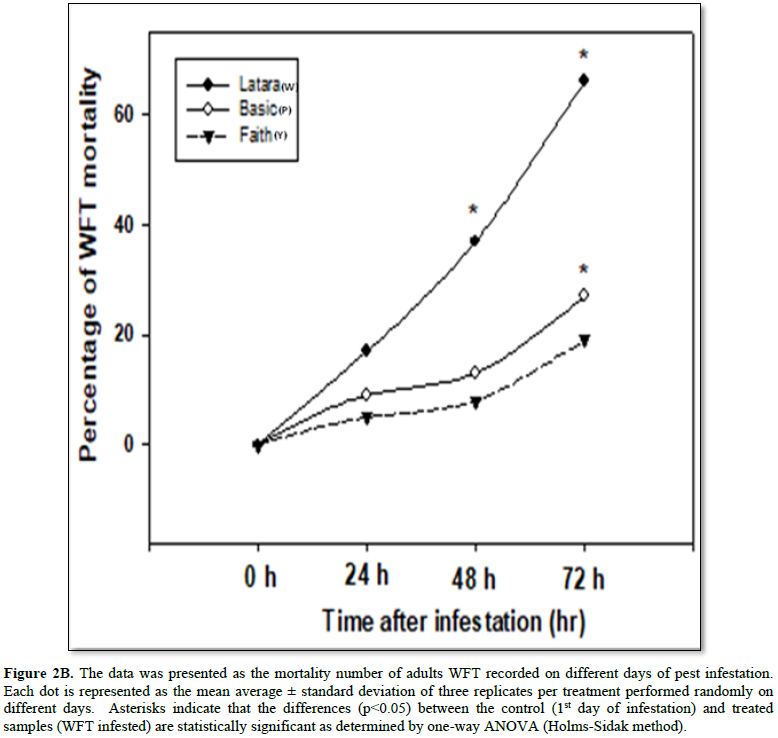Research Article
Evaluation of Gerbera Genotypes for Resistance to Western Flower Thrip Infestation
572
Views & Citations10
Likes & Shares
Plants being sessile face huge stress against biotic and abiotic stress as they cannot escape from it. Gerbera jamesonii Bolus ex Hooker F is commercially grown for its attractive flowers globally is severely affected by western flower thrip (WFT, Frankliniella occidentalis (Pergande) (Thysanoptera: Thripidae). The objective of the current study is to identify resistant genotype of Gerbera and for which three Gerbera genotypes (Latara - White flowered genotype; Basic - Pink flowered genotype and Faith- Yellow flowered genotype) were infested with laboratory reared WFT under greenhouse conditions. The morphological studies were carried out by comparing control, 3rd day and 7th day infested floral buds among three genotypes of Gerbera. The mortality rate was also observed every 24 h till 72 h after pest infestation. Morphological differences were perceived in pink and yellow genotypes upon exposure to WFT with noticeable deformed petals and silvery lesions in contrast to white genotype. After 72 h of pest infestation, the mortality was visually assessed using an index ranging from 0% (no mortality) to 60% (high mortality). The white flowered genotype showed higher level of resistance, pink is moderately resistant and yellow is susceptible to WFT. Our present study will be helpful for further comparative, biochemical, defense mechanisms and genetic studies to develop WFT management strategies.
Keywords: Frankliniella occidentalis, Gerbera jamesonii, Mortality, WFT Infestation
Abbreviations: WFT: Western Flower Thrip; DPI: Day of Pest Infestation
INTRODUCTION
Gerbera is an important ornamental plant grown throughout the world for its cut-flower production, as well as potted plant [1,2]. It is commonly known as Transvaal Daisy, Barberton Daisy or African daisy and is cultivated commercially in greenhouses under a wide range of climatic conditions [3,4]. In the terms of economic value, it ranks fourth in the global cut flower market after Rose, Chrysanthemum, and Tulip [5]. It became a model plant to study flower development in Compositae members.
The invasion of Western Flower Thrip (WFT, Frankliniella occidentalis (Pergande) (Thysanoptera: Thripidae), a polyphagous pest has threatened several ornamental and crop plants by feeding and acting as a primary vector for diseases caused by tospoviruses globally [6,7]. WFT, native to Western North America, received little attention as a pest until a pesticide-resistant strain emerged from California greenhouses in the 1970s [8]. Later on, due to the invasiveness of WFT, it attained global pest status as they have been transported on agricultural produce [9,10]. The WFT are minute insects ranging in size between 1 to 4 mm in length and its life cycle of consists of egg, two active feeding larval instars, two quiescent, non-feeding instars, the pre-pupa, pupa, and the adult stages [11,12].
The WFT also limits crop productivity in ornamental plants, particularly in Gerbera causing aesthetic damage and incompatible with the global market. In Gerbera, WFT causes deformations on growing plant parts and flowers (silver lesions), resulting in distorted petals, discoloration, and streaks [13]. Being tiny, WFT tends to occupy narrow crevices within or between plant parts (flowers) and gets protected from predators and insecticides as well. Several pest management strategies have been successfully deployed till date to control insect pests which include biological, chemical, and manual control methods (using insect traps) [14,15]. However, non-specificity and increased pest resistance among evolving insects limit the application of biological and chemical control methods. The emergence of insecticide resistance globally among WFT made the situation even worse in eradication or control, thus there is an urgent need to intensify the search for plant resistance mechanisms [16,17]. In view of the above, we attempted for the first time to screen Gerbera genotypes (White flowered genotype aka Latara; Pink flowered genotype aka Basic and Yellow flowered genotype aka Faith) resistant to WFT.
MATERIALS AND METHODS
Plant Material
One month old plantlets of three cultivars of Gerbera jamesonii cv. Bolus L. (White, Pink, and Yellow colored flower varieties) were procured from Virat Agri Biotech (VAB), Nizamabad, Telangana, potted in plastic pots containing sand: cocopeat: soil (1:1:1) mixture and raised in a green/net house by maintaining controlled conditions (day/night temperatures of 27-29/23-25°C and relative humidity of 45-51%, respectively for the entire growth period).
Insect rearing
WFT used in the given study were collected from Gerbera farmhouse and reared under standard conditions. The rearing blocks were made of a transparent plastic box (28 cm width, 20 cm length, 10 cm height) with a perforated lid and covered by a nylon filter (30 µm) for aeration (Figure 1A). A glass rod was placed diagonally inside the box with a coating of 5 ml of a 10% (w/v) sucrose solution which serves as a nutrient medium for the development of adult WFT and an egg deposition site (Figure 1B). Apart from sucrose solution, fresh gerbera florets which served as a natural food source were placed inside a block. The rearing block is lit with a 100-watt bulb to keep it warm.
Infestation of Gerbera by WFT
Morphological studies
The three genotypes of Gerbera (White, Pink and Yellow) were introduced to WFT and observed for 7 days for morphological changes.
Mortality studies
The emerging 3-day old flower buds of White, Pink, and Yellow cultivars of Gerbera were infested with an equal number of adult WFT (about 20 no’s) and left for 3 days in a separate block covered with a nylon filter (30 µm) grown under greenhouse conditions (Figures 1C-D).
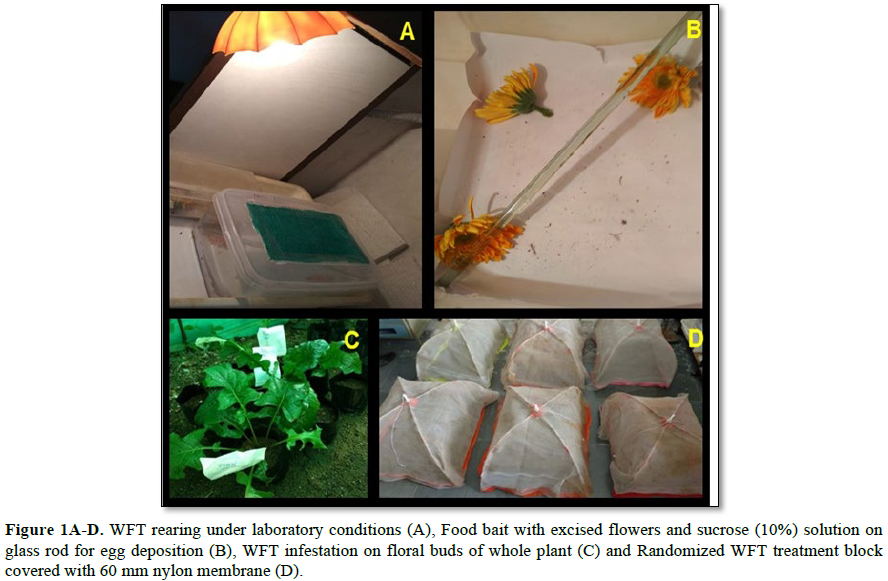

RESULTS AND DISCUSSION
Differential response of three different cultivars of Gerbera towards WFT infestation
In the given study, we focused on evaluating the resistance of different cultivars of Gerbera against WFT. At the first acquaintance, we noticed clear morphological differences in White, Pink, and Yellow cultivars upon exposure to WFT with conspicuous deformed petals in Yellow and Basic cultivars with silvery lesions. In contrast, The White flowered genotypes did not show any sort of morphological changes upon WFT infestation. These findings clearly illustrate the resistance and susceptibility of these three cultivars, White - resistant; Basic - moderately resistant and Yellow - susceptible (Figure 2A). The differential pattern exhibited by these three cultivars against WFT has motivated us to investigate more into their biochemical defense mechanisms behind the resistance mechanisms of white flower genotype against WFT.
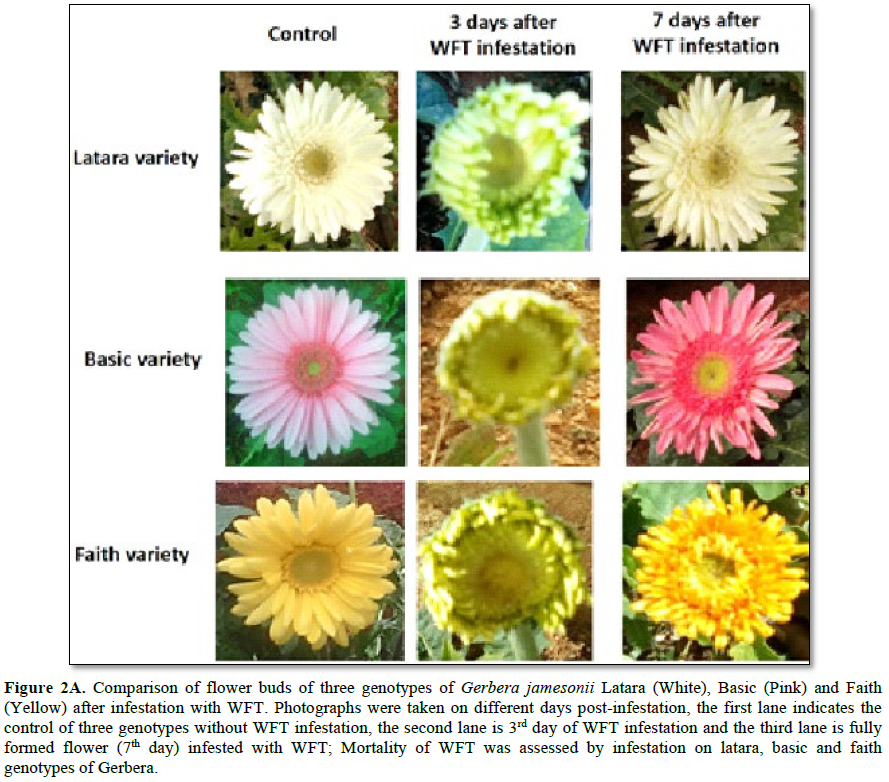
Variation in the rate of mortality of WFT on floral buds of White, Pink, and Yellow cultivars

Variation in the rate of mortality of WFT on floral buds of White, Pink, and Yellow cultivars
Of the three Gerbera cultivars tested, the mortality rate of WFT when inoculated on floral buds of pink progressively increased from 3 DPI, while this increment was significantly high in White. Whereas in Yellow, instead of mortality the number of WFT multiplied drastically from 5 DPI and reached a maximum at 7 DPI (Figure 2B), this rise in the number was also significant especially after 5 DPI [18].
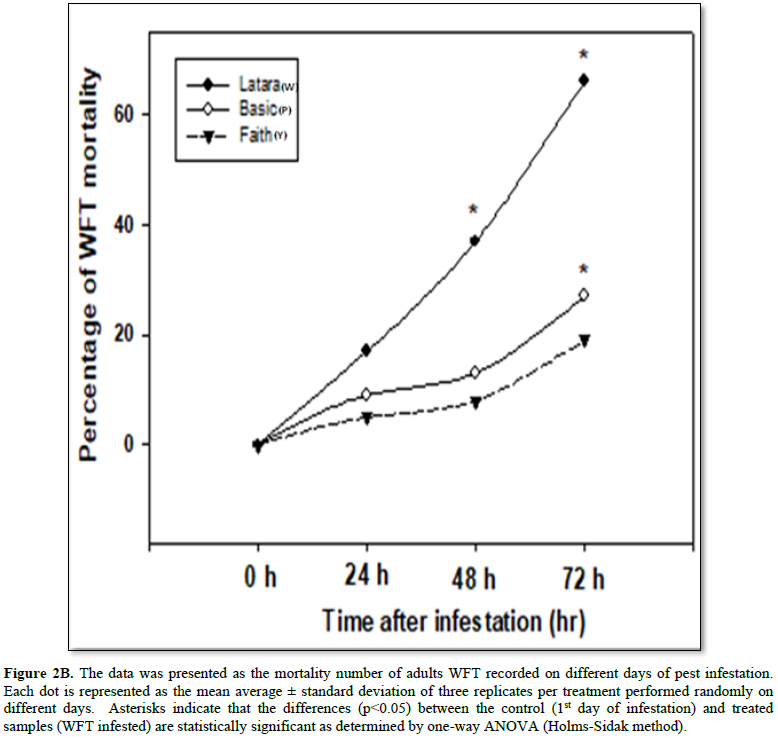

CONCLUSION
The white cultivar showed higher resistance to WFT than the pink (moderately resistant) and yellow (susceptible) cultivars. Our present studies on morphology and mortality may be helpful to confer the defense mechanism in resistant genotypes against WFT. Till date, this is the first report on confirming the WFT resistance/susceptibility by Gerbera genotypes which not only help to understand the modus operandi of secondary metabolites or other resistance factors of white genotype but also extend such studies in other ornamental plants.
ACKNOWLEDGEMENTS
We are thankful to the Head, Department of Biotechnology, Telangana University for providing research facilities. We are grateful to VAB, Nizamabad for their continuous support for carrying out experimental studies.
- Gerin C, Hance TH, Van Impe G (1994) Demographical parameters of Frankliniella occidentalis (Pergande) (Thysanoptera: Thripidae). J Appl Entomol 118(1-5): 370-377.
- Cloyd RA (2009) Western flower thrips (Frankliniella occidentalis) management on ornamental crops grown in greenhouses: Have we reached an impasse? Pest Technol 3(1): 1-9.
- Moyer C, Peres NA (2008) Evaluation of biofungicides for control of powdery mildew of gerbera daisy. Proc Fla State Hort Soc 121: 389-394.
- Simpson BB (2009) Economic Importance of Compositae, in Systematics, Evolution, and Biogeography of Compositae, eds Funk VA, Susanna A, Stuessy TF, Bayer RJ (Vienna: International Association for Plant Taxonomy), pp: 45-58.
- Sharma V, Karma G, Thakur R, Kaur R (2018) Extending post-harvest life and keeping quality of Gerbera (Gerbera Jamesonii) using 8-HQS and Calcium chloride with sucrose. Int J Pharm Sci Res 6: 1-9.
- Morse JG, Hoddle MS (2006) Invasion biology of thrips. Ann Rev Entomol 51: 67-89.
- Mouden S, Sarmiento KF, Klinkhamer PG, Leiss KA (2017) Integrated pest management in western flower thrips: past, present and future. Pest Management Sci 73: 813-822.
- Reitz SR, Gao Y, Kirk WDJ, Hoddle MS, Leiss KA, et al. (2020) Invasion Biology, Ecology, and Management of Western Flower Thrips. Ann Rev Entomol 65: 17-37.
- Kirk WDJ, Terry LI (2003) The spread of the western flower thrips Frankliniella occidentalis (Pergande). Agric Forest Entomol 5: 301-310.
- Reitz SR (2009) Biology and ecology of the western flower thrips (Thysanoptera: Thripidae): The making of a pest. Florida Entomol 92: 7-13.
- Reitz SR, Gao Y, Lei Z (2011) Thrips: Pests of concern to China and the United States. Agric Sci China 10: 867-892.
- Lewis T (1973) Thrips: Their biology, ecology and economic importance. Academic Press, New York, USA.
- Bueno VHP (2005) Controle Biológico de pulgões ou afídeos-praga em cultivos protegidos. Inf Agrop 26: 9-17.
- Bielza P (2008) Insecticide resistance management strategies against the western flower thrips, Frankliniella occidentalis. Pest Manag Sci 64: 1131-1138.
- Broughton S, Herron GA (2009) Potential new insecticides for the control of western flower thrips (Thysanoptera: Thripidae) on sweet pepper, tomato, and lettuce. J Economic Entomol 102: 646-651.
- Jensen SE (2000) Insecticide resistance in the western flower thrips, Frankliniella occidentalis. Integr Pest Manag Rev 5: 131-146.
- Gao YF, Gong YJ, Cao LJ, Chen JC, Gao YL, et al. (2021) Geographical and interspecific variation in susceptibility of three common thrips species to the insecticide, spinetoram. J Pest Sci 94: 93-99.
- Li Y, Hill CB, Hartman GL (2004) Effect of three resistant soybean genotypes on the fecundity, mortality, and maturation of the soybean aphid, Aphis glycines (Homoptera: Aphididae). J Econ Entomol 97: 1106-1111.

